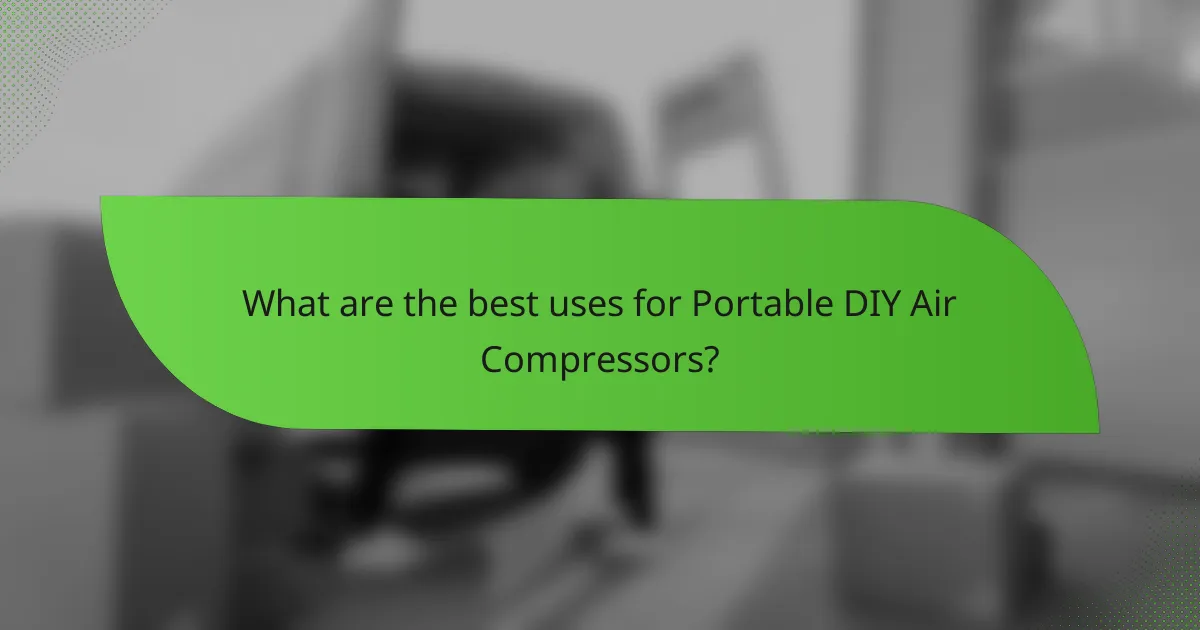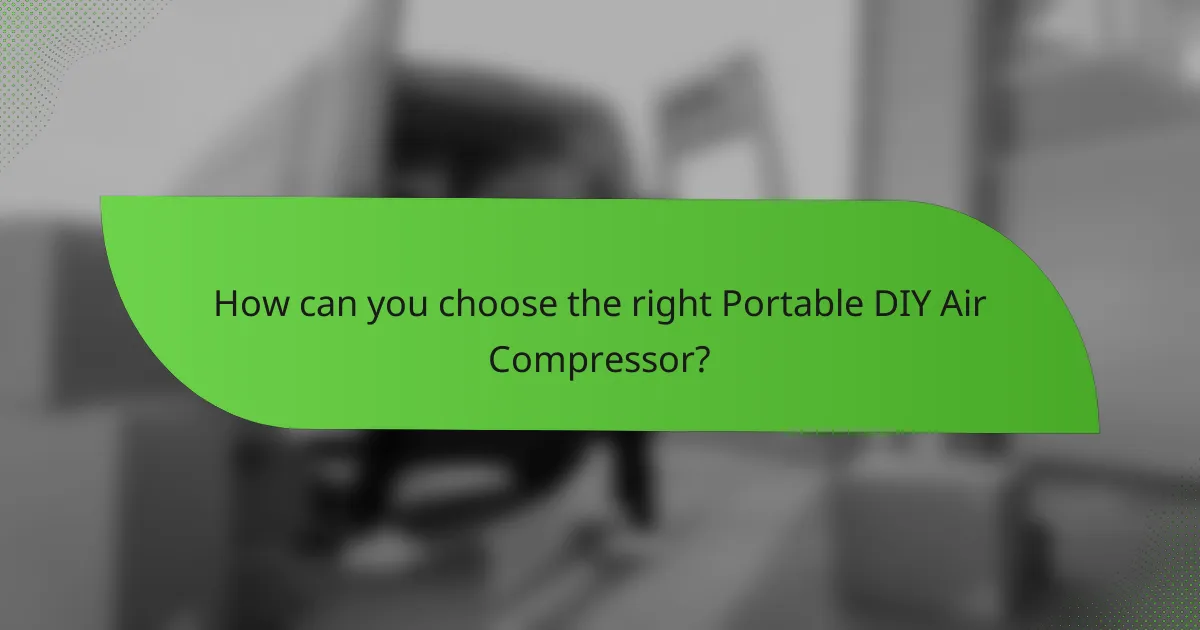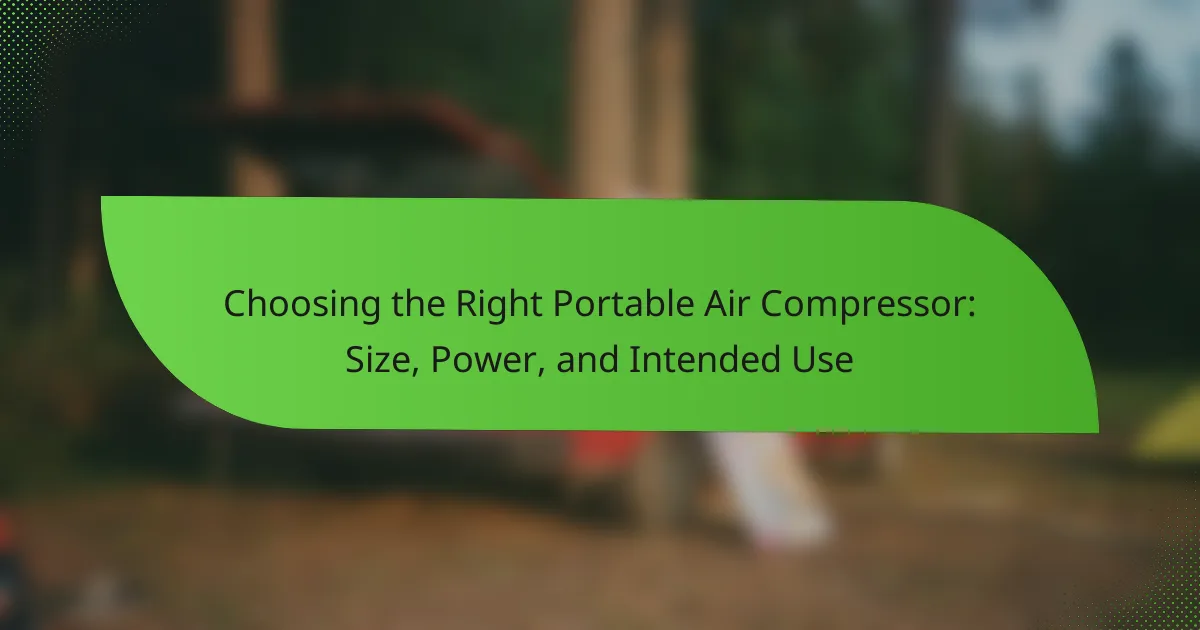Portable DIY air compressors are compact, lightweight devices designed for various applications, including inflating tires, powering tools, and cleaning surfaces. These compressors often come with a built-in tank for storing compressed air and can be powered by electricity or batteries. Their versatility makes them suitable for both home and professional use, catering to tasks such as inflating sports equipment and operating pneumatic tools like nail guns and spray guns. When selecting a portable DIY air compressor, it is essential to consider factors such as intended use, required pressure, CFM rating, tank size, weight, and power source options, ensuring that the chosen model meets safety standards and efficiency needs.

What are Portable DIY Air Compressors?
Portable DIY air compressors are compact devices designed for inflating tires, powering tools, and performing various tasks. They are lightweight and easy to transport. These compressors often feature a built-in tank for storing compressed air. Many models are powered by electricity or batteries. Portable DIY air compressors are popular among hobbyists and professionals alike. They provide convenience for tasks at home or on the go. Their versatility makes them suitable for a range of applications, from inflating sports equipment to operating pneumatic tools. The demand for portable air compressors has increased due to their practicality and efficiency.
How do Portable DIY Air Compressors function?
Portable DIY air compressors function by converting power into potential energy stored in pressurized air. They typically use an electric motor or gasoline engine to drive a piston or diaphragm. This mechanism compresses air, increasing its pressure. The compressed air is then stored in a tank until needed. When the user activates the tool or appliance, the stored air is released. This process provides the necessary force to power various tools like nail guns or inflators. The efficiency and effectiveness of these compressors make them suitable for a wide range of DIY tasks.
What are the essential components of Portable DIY Air Compressors?
The essential components of Portable DIY Air Compressors include the motor, compressor pump, air tank, pressure switch, and regulator. The motor powers the compressor pump, which compresses air. The air tank stores the compressed air for later use. The pressure switch controls the motor based on the air pressure in the tank. The regulator manages the output pressure of the air. Each component works together to ensure efficient operation and usability.
How does the mechanism of air compression work?
Air compression works by reducing the volume of air, which increases its pressure. This is achieved through mechanical means, typically using a piston or a diaphragm. As the piston moves inward, it compresses the air in a confined space. This process raises the air’s pressure due to the reduction in volume.
The compressed air can then be stored in a tank for later use. When released, the high-pressure air expands, creating airflow that can power tools or inflate objects. Air compressors operate based on the principles of Boyle’s Law, which states that pressure and volume are inversely related in a closed system.
In practical applications, portable DIY air compressors often use electric motors to drive the compression mechanism. These devices are widely used in various tasks, ranging from inflating tires to powering pneumatic tools.
What are the key features of Portable DIY Air Compressors?
Portable DIY air compressors are compact devices designed for various inflation and power tasks. They typically feature a lightweight design for easy transport. Most models come with a built-in pressure gauge for accurate inflation monitoring. Many portable compressors include multiple nozzle attachments for different applications. They often have a quick-connect coupling for fast hose attachment. A key feature is their ability to operate on standard household outlets or car batteries. Most units provide a noise-reducing design for quieter operation. Some models offer automatic shut-off capabilities to prevent over-inflation. These features make portable DIY air compressors versatile for home and outdoor use.
What specifications should you look for in Portable DIY Air Compressors?
When selecting Portable DIY Air Compressors, key specifications include tank capacity, PSI rating, and CFM output. Tank capacity affects how much air is stored for use. A larger tank allows for longer usage without needing to refill. The PSI rating indicates the maximum pressure the compressor can achieve. Higher PSI ratings are essential for tasks requiring more power. CFM output measures the airflow rate, impacting the speed at which tasks can be completed. A higher CFM is beneficial for tools that require more air. Additionally, consider the weight and portability for ease of transport. Noise level is another important factor, especially for residential use. These specifications ensure the compressor meets your project needs effectively.
How do the size and weight of Portable DIY Air Compressors impact usability?
The size and weight of portable DIY air compressors significantly impact usability. Smaller and lighter models are easier to transport and store. They can fit into tight spaces, making them more versatile for various tasks. Heavier models may offer more power but can be cumbersome to move. Users may prefer lightweight options for quick jobs or when mobility is essential. Additionally, the size affects air tank capacity, influencing the duration of use before needing a refill. A balance between size, weight, and power is crucial for optimal usability in diverse applications.
What benefits do Portable DIY Air Compressors provide?
Portable DIY air compressors provide convenience and versatility for various tasks. They are lightweight and easy to transport, making them ideal for home and outdoor use. These compressors can inflate tires, sports equipment, and air mattresses quickly. They are also useful for powering pneumatic tools like nail guns and impact wrenches. Many models offer adjustable pressure settings for different applications. Additionally, portable DIY air compressors can save time compared to manual inflation methods. Their compact size allows for easy storage in small spaces. Overall, they enhance efficiency in DIY projects and maintenance tasks.
How do Portable DIY Air Compressors enhance project efficiency?
Portable DIY air compressors enhance project efficiency by providing quick and reliable power for various tasks. They enable faster inflation of tires, air tools, and other equipment. This reduces downtime and allows for continuous workflow. Portable models are lightweight and easy to transport, making them ideal for on-the-go projects. Their versatility allows users to tackle multiple tasks with one tool. Many models feature adjustable pressure settings, ensuring optimal performance for specific applications. According to a study by the Association of Equipment Manufacturers, using air compressors can increase productivity by up to 30%. This highlights their impact on enhancing efficiency in DIY projects.
What cost savings can be associated with using Portable DIY Air Compressors?
Portable DIY air compressors can lead to significant cost savings. They reduce the need for professional services. Many tasks, like inflating tires or powering tools, can be done independently. This eliminates labor costs associated with hiring professionals. Additionally, owning a portable unit avoids rental fees for compressors. The average rental fee can be around $50 per day. Regular use of a portable compressor can save hundreds annually. Furthermore, these compressors are often energy-efficient, reducing electricity costs. Overall, the investment in a portable DIY air compressor pays off through these savings.

What are the best uses for Portable DIY Air Compressors?
Portable DIY air compressors are best used for inflating tires, powering pneumatic tools, and cleaning surfaces. They efficiently inflate car, bike, and sports equipment tires. These compressors can also power nail guns, spray guns, and impact wrenches. Additionally, they are effective for cleaning hard-to-reach areas with compressed air. Their portability allows for convenient use in various locations. Many models are lightweight and easy to transport, enhancing their usability. The versatility of portable DIY air compressors makes them valuable for both home and professional projects.
In which DIY projects are Portable DIY Air Compressors most effective?
Portable DIY air compressors are most effective in projects such as inflating tires, powering pneumatic tools, and spray painting. They efficiently inflate car and bicycle tires quickly. Many portable models deliver sufficient pressure for nail guns and staplers. Additionally, they provide a consistent air supply for spray painting tasks. Their compact size allows for easy transport and storage. These compressors are often used in woodworking projects for fastening materials. They are also beneficial for cleaning dust from tools and machinery. Overall, their versatility makes them ideal for various DIY applications.
How can Portable DIY Air Compressors assist in automotive tasks?
Portable DIY air compressors assist in automotive tasks by providing a convenient source of compressed air. They can inflate tires quickly and efficiently, ensuring proper tire pressure for safety and performance. These compressors often feature built-in gauges for accurate pressure readings. They can also power pneumatic tools, such as impact wrenches and nailers, enhancing repair and maintenance capabilities. Many models are lightweight and portable, making them easy to transport to different locations. Additionally, they are typically designed for easy operation, allowing users to complete tasks without extensive training. Their versatility makes them suitable for various automotive applications, from routine maintenance to emergency repairs.
What home improvement tasks benefit from Portable DIY Air Compressors?
Portable DIY air compressors benefit various home improvement tasks. They are ideal for inflating tires, which is a common maintenance task. They can power pneumatic tools like nail guns for woodworking projects. Painting projects also benefit, as air compressors can spray paint evenly. Cleaning tasks are simplified with air compressors for blowing dust from hard-to-reach areas. They assist in operating airbrushes for detailed artwork or crafts. Additionally, they can help with various DIY tasks that require air pressure, enhancing efficiency. Their versatility makes them valuable for homeowners engaged in multiple projects.
What industries utilize Portable DIY Air Compressors?
Portable DIY air compressors are utilized in various industries. These include automotive, construction, and manufacturing. In the automotive industry, they are used for inflating tires and powering pneumatic tools. The construction industry relies on them for powering nail guns and other equipment. Manufacturing utilizes portable air compressors for assembly line operations and equipment maintenance. Additionally, the woodworking industry uses them for airbrushing and sanding tools. These applications demonstrate the versatility and importance of portable DIY air compressors across multiple sectors.
How do contractors benefit from using Portable DIY Air Compressors?
Contractors benefit from using portable DIY air compressors by gaining versatility and efficiency on job sites. These compressors are lightweight and easy to transport, allowing contractors to move them between different locations effortlessly. They provide a reliable source of compressed air for various tools, such as nail guns and spray painters, enhancing productivity. The ability to operate in tight spaces makes them ideal for residential projects. Many portable models are designed for low noise, which is beneficial in noise-sensitive environments. Additionally, their quick setup time allows contractors to start work without delays. Many portable DIY air compressors also have multiple output ports, enabling simultaneous tool usage. This feature streamlines workflows and maximizes efficiency on the job site.
What role do Portable DIY Air Compressors play in the manufacturing sector?
Portable DIY air compressors play a vital role in the manufacturing sector. They provide a convenient and efficient source of compressed air for various applications. These compressors are used for powering pneumatic tools, such as nail guns and spray guns. They facilitate tasks like painting, inflating, and cleaning. Portable models offer flexibility and mobility on job sites. This allows workers to easily transport them as needed. Their compact size makes them suitable for small workshops and tight spaces. The demand for portable air compressors in manufacturing has increased due to their versatility and ease of use.

How can you choose the right Portable DIY Air Compressor?
To choose the right portable DIY air compressor, consider the intended use and required pressure. Identify the tools that will be powered by the compressor. Check the CFM (cubic feet per minute) rating needed for those tools. Look for a compressor that meets or exceeds that CFM requirement. Evaluate the tank size for continuous use; larger tanks provide longer run times. Assess the weight and portability if frequent transport is necessary. Review the power source options, such as electric or gas, based on availability and convenience. Ensure the compressor has safety features like automatic shut-off and pressure regulation.
What factors should you consider when selecting a Portable DIY Air Compressor?
When selecting a Portable DIY Air Compressor, consider its pressure output, tank size, and portability. Pressure output is measured in PSI (pounds per square inch) and affects the compressor’s ability to power tools. A tank size of 1 to 6 gallons is common for DIY tasks. Portability is influenced by weight and design, essential for easy transport. Noise level is also important; quieter models are preferable for residential areas. Power source matters too; electric compressors are suitable for home use, while gas models offer more mobility. Finally, check for additional features like built-in gauges and hose storage for convenience.
How do power source options influence your choice of Portable DIY Air Compressor?
Power source options significantly influence the choice of a Portable DIY Air Compressor. The main types of power sources include electric, battery-operated, and gas-powered models. Electric compressors are ideal for home use, providing consistent power and efficiency. Battery-operated models offer portability and convenience for remote locations but may have limited runtime. Gas-powered compressors deliver high power and are suitable for outdoor use, yet they require fuel and maintenance. Each power source affects the compressor’s performance, weight, and ease of use. Thus, selecting a power source aligns with specific project needs and user preferences.
What is the importance of tank capacity in Portable DIY Air Compressors?
Tank capacity in portable DIY air compressors is crucial for determining the amount of compressed air available for use. A larger tank allows for extended operation without frequent cycling of the compressor. This is especially important for tasks that require a continuous air supply, such as spray painting or inflating tires.
Conversely, a smaller tank may lead to interruptions as the compressor needs to refill more often. For instance, a 6-gallon tank can provide a steady airflow for various applications, while a 1-gallon tank may require more frequent pauses.
Thus, choosing the appropriate tank capacity directly impacts efficiency and productivity in DIY projects.
What tips can help you maximize the use of Portable DIY Air Compressors?
To maximize the use of portable DIY air compressors, ensure proper maintenance. Regularly check and clean the air filter to maintain optimal airflow. Monitor the oil levels in oil-lubricated models to ensure efficiency. Use the correct pressure settings for specific tasks to avoid damage. Store the compressor in a dry place to prevent rust and corrosion. Keep hoses and attachments in good condition to prevent leaks. Familiarize yourself with the compressor’s manual for specific usage guidelines. Lastly, always use safety gear when operating the compressor to protect against potential hazards.
How can regular maintenance improve the lifespan of Portable DIY Air Compressors?
Regular maintenance can significantly improve the lifespan of portable DIY air compressors. This involves routine checks on components such as filters, hoses, and oil levels. Keeping filters clean ensures optimal airflow, which prevents overheating. Inspecting hoses for leaks prevents loss of pressure and enhances efficiency. Regular oil changes reduce friction within the motor, promoting smoother operation. Additionally, checking for any loose parts can prevent mechanical failures. According to a study by the American Society of Mechanical Engineers, regular maintenance can extend equipment life by up to 30%. This highlights the importance of consistent upkeep for maximizing performance and longevity.
What safety precautions should be taken when using Portable DIY Air Compressors?
When using portable DIY air compressors, wear appropriate personal protective equipment (PPE) such as safety goggles and hearing protection. Ensure the compressor is placed on a stable surface to prevent tipping. Always check for leaks in hoses and connections before use. Maintain a safe distance from the compressor while it is operating. Do not exceed the manufacturer’s recommended pressure settings to avoid explosions. Use the compressor in well-ventilated areas to prevent carbon monoxide buildup. Regularly inspect and maintain the compressor to ensure it is in good working condition. Following these precautions reduces the risk of accidents and injuries associated with air compressors.
Portable DIY air compressors are compact devices designed for various inflation and power tasks, offering convenience for both hobbyists and professionals. This article explores their essential features, including components, functionality, and specifications, while highlighting the benefits they provide in enhancing project efficiency and achieving cost savings. Additionally, it discusses the best uses across different applications, such as automotive and home improvement tasks, and outlines key considerations for selecting the right model, including power source options and tank capacity. Safety precautions and maintenance tips are also provided to ensure optimal performance and longevity of these versatile tools.



